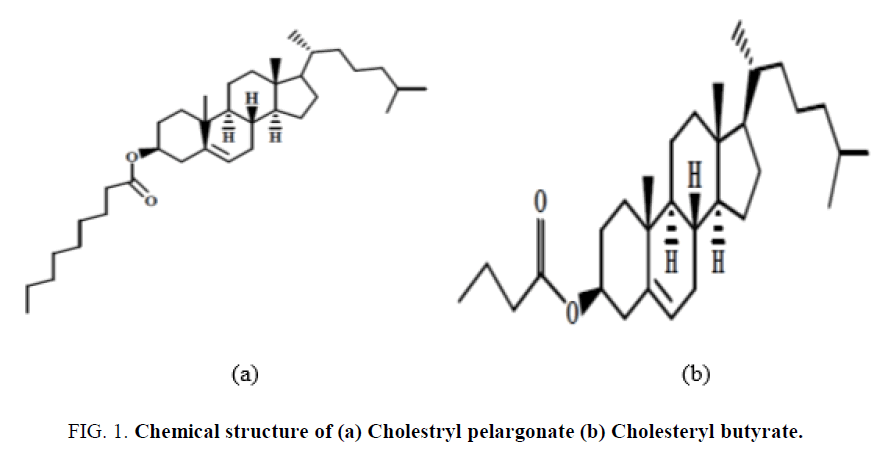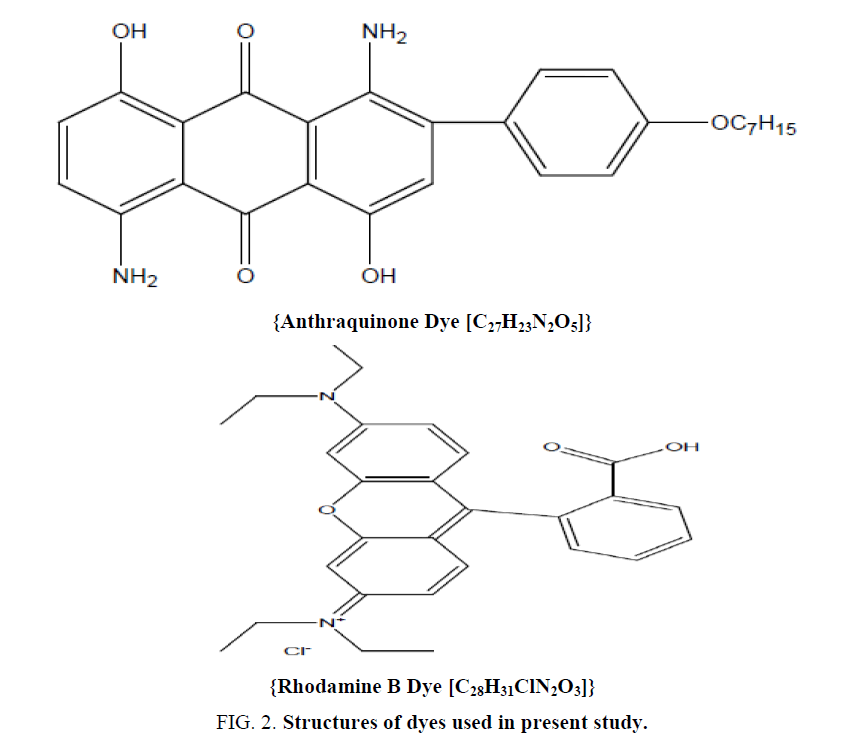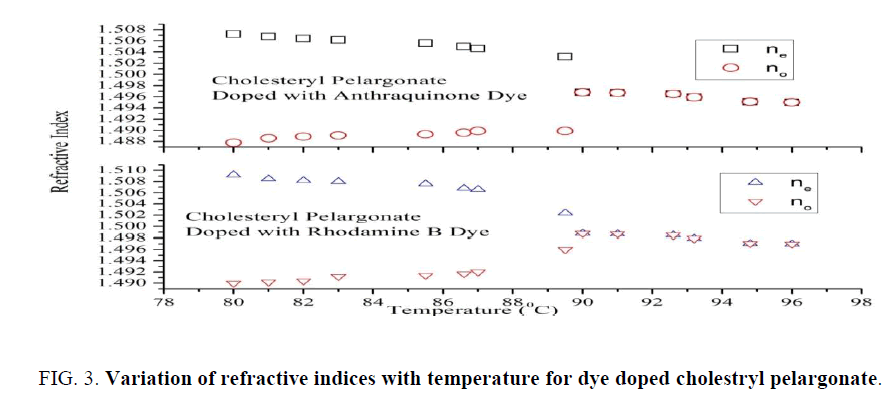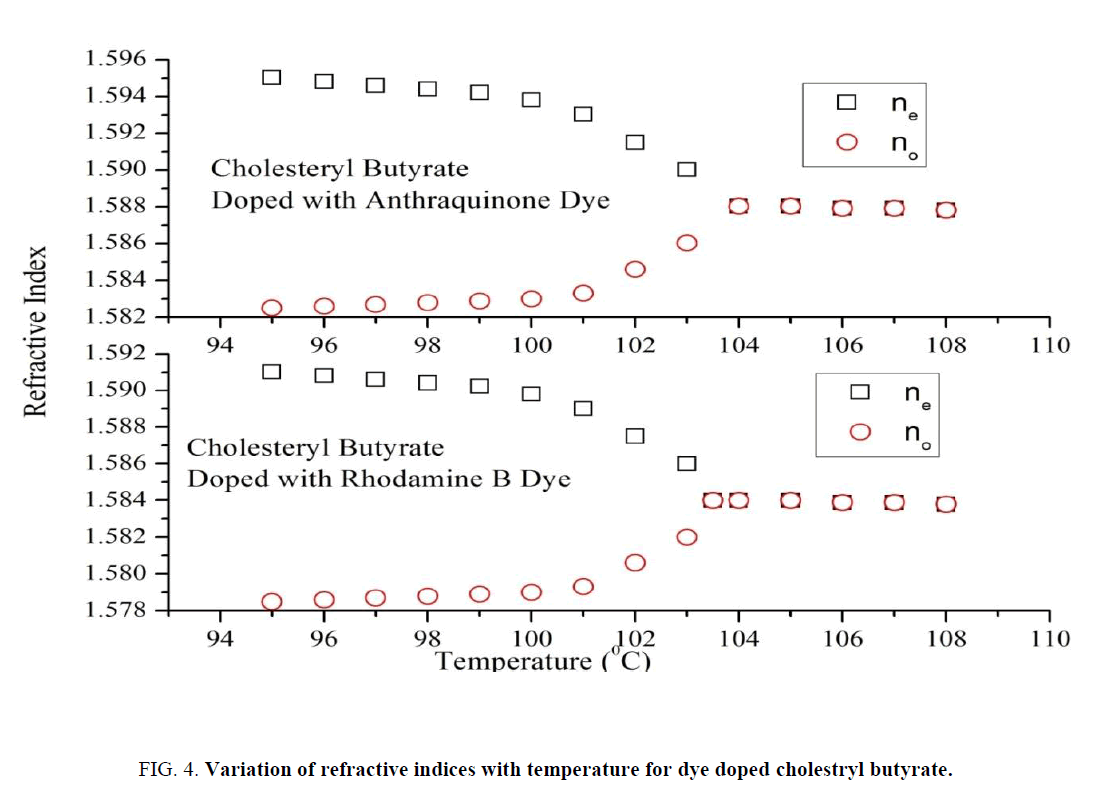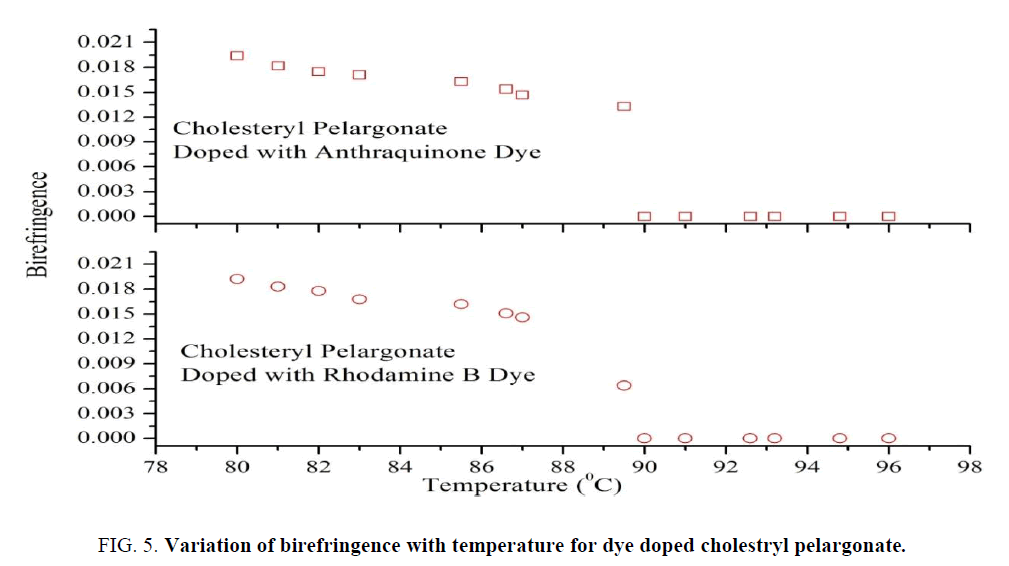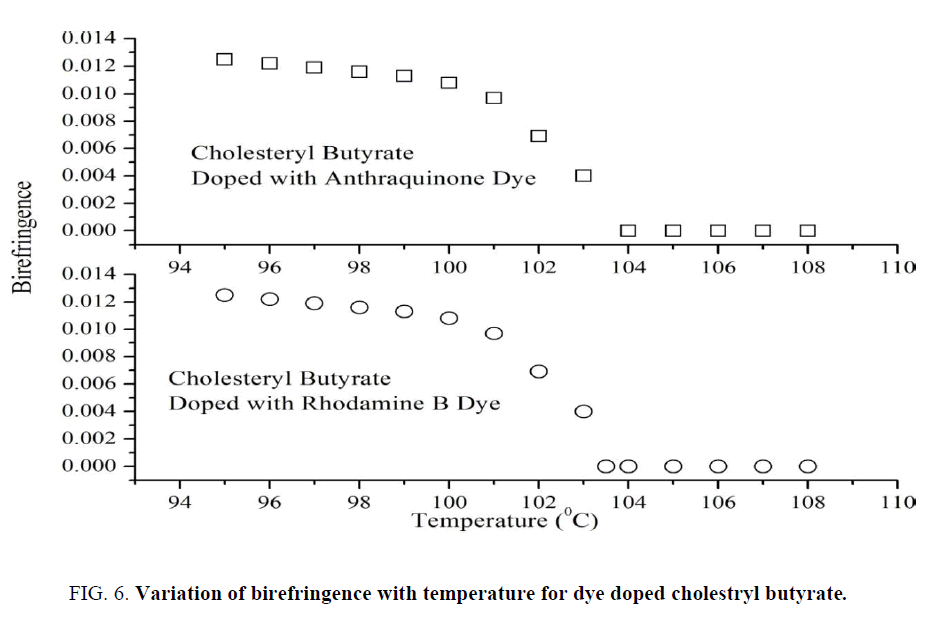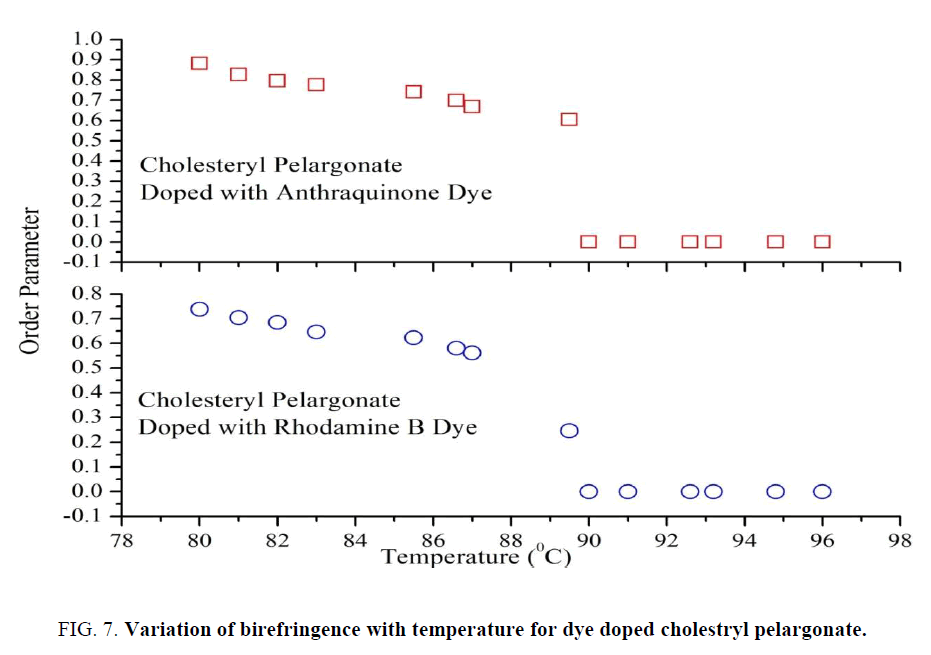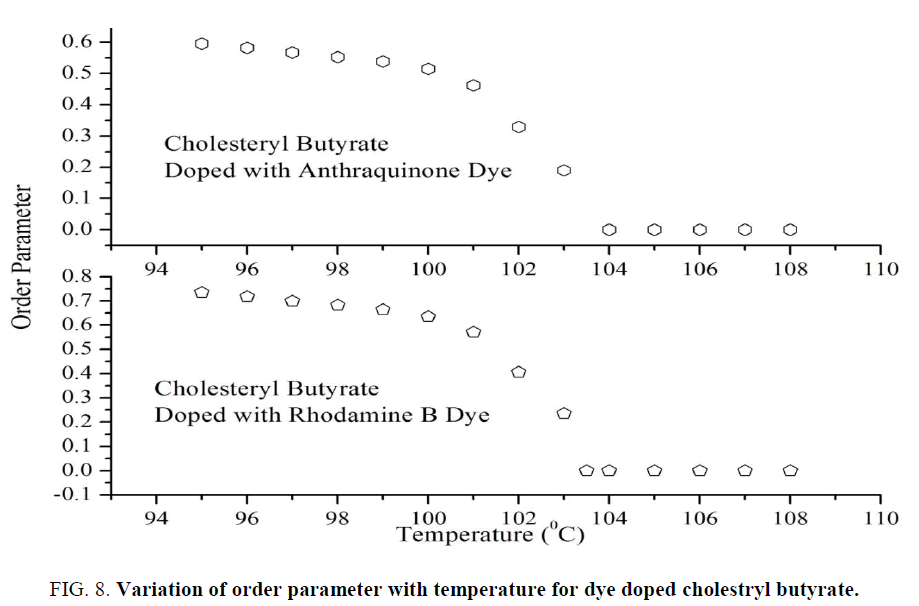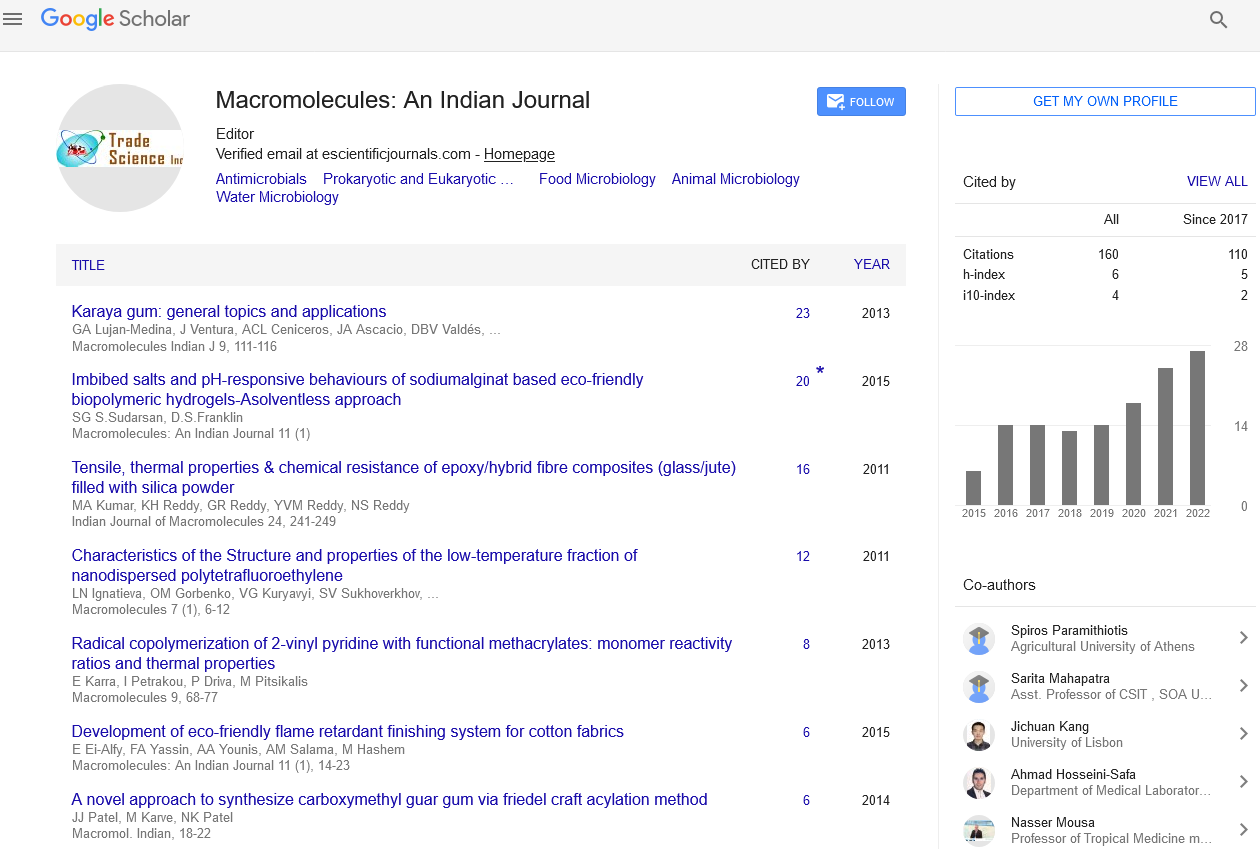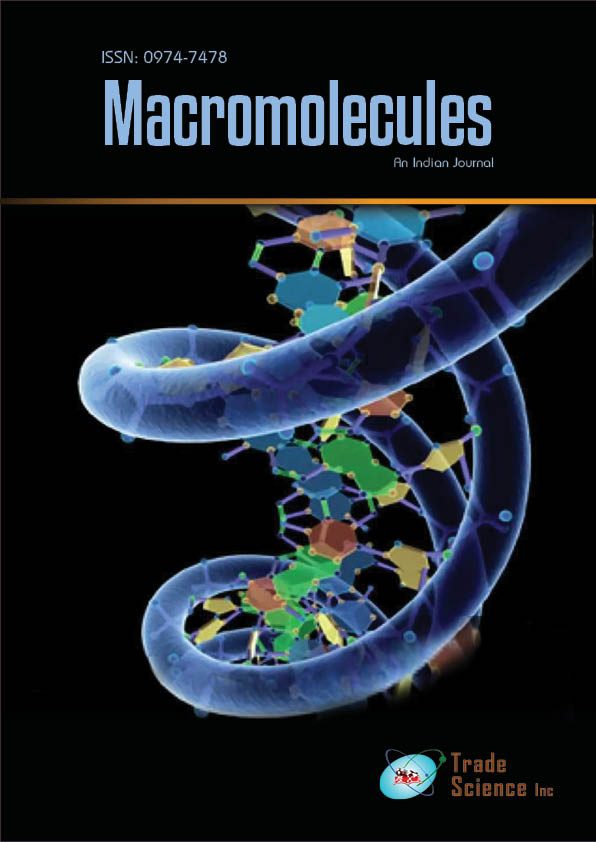Original Article
tsm, Volume: 12( 2)Optical Studies of Dye Doped Cholesteric Liquid Crystals
- *Correspondence:
- Porov P, Department of Physics, Integral University, Lucknow, India, Tel: 0522-2890730; E-mail: preetiabhas@gmail.com
Received: March 18, 2017; Accepted: June 05, 2017; Published: June 08, 2017
Citation: Porov P, Chandel VS, Manohar R. Optical Studies of Dye Doped Cholesteric Liquid Crystals. Macromol Ind J.2017;12(2):107.
Abstract
The present paper reports the effect of anthraquinone and rhodamine B dye on optical parameters of two cholesteric liquid crystals namely cholestryl pelargonate (CP) and cholestryl butyrate (CB). The refractive indices, order parameter and birefringence of dyes doped cholesteric liquid crystals have been measured and behavior of these parameters with variation in temperature have been discussed only in the cholesteric phase. The refractive indices, order parameter and birefringence show significant variation with the addition of anthraquinone and rhodamine B dye in pure cholesteric liquid crystals.
Keywords
Cholesteric liquid crystal; Refractive index; Birefringence; Order parameter
Introduction
The importance of liquid crystalline materials is increasing continually due to their extensive use in display technology and other devices [1]. Cholesteric liquid crystals (CLC), are a class of materials with very interesting optical properties. CLCs are used frequently in electro-optic displays and also in thermo graphic applications [2-4]. For application of any liquid crystal in a practical device, it is difficult to identify a single liquid crystal that fulfills all the required conditions. Therefore, the different mixtures of liquid crystals and their doped samples have come to play a key role for high quality performance of the devices [5-8]. The doping can be done by dyes, polymers and different nanoparticles [9-12]. The presence of dye molecules in the liquid crystal doping significantly changes the intermolecular interaction of LC molecules and influences many properties of the pure liquid crystals [13,14]. The molecular structure of dyes is like the molecules of liquid crystals. However, the magnitude for the ordering of the dye is very essential. The orientation ordering in dye-doped liquid crystalline systems depends on the shapes of both the liquid crystal molecule and the dye molecule [15,16]. If the dye molecule is long, it’s ordering can be high in comparison to the ordering of the liquid crystal.
Most of the investigations on dye-doped liquid crystals are concentrated around their dielectric and electro-optical properties that affect the performance of the practical devices directly [17-19]. However, the order parameter of a liquid crystal is an important parameter, which governs most of the anisotropic properties of liquid crystals [20]. The orientationally order parameter in a liquid crystal at different temperatures can be estimated by studying the birefringence.
In the present chapter, we have observed the effect of anthraquinone and rhodamine B dye on optical parameters of two cholesteric liquid crystals namely cholestryl pelargonate (CP) and cholestryl butyrate (CB). The refractive indices, order parameter and birefringence of dyes doped cholesteric liquid crystals have been measured and behavior of these parameters with variation in temperature have been discussed. The refractive indices, birefringence, order parameter and dielectric parameters for pure cholestryl pelargonate and cholestryl butyrate and their binary mixtures have already been reported by our group [21,22].
Materials and Methods
Experimental procedures
Material used: The cholesteric liquid crystals cholesteryl pelargonate and cholesteryl butyrate doped with two dyes anthraquinone and rhodamine B have been used for present study. The chemical structures of both the liquid crystals are shown in Figure 1.
The phase transition schemes of the pure cholesteryl pelargonate is:

The phase transition schemes of the pure cholesteryl butyrate is:

The structures and composition of anthraquinone dye [1, 5-Diamino-2 (4-heptyloxy-phenyl)-4, 8-dihydroxy-anthraquinone] and rhodamine B dye [N-{9-(2-Carboxyphenyl)-6-diethylamino)-3H-xanthen-3-ylidene}-N-ethylethanaminium chloride are shown in Figure 2.
Refractive index measurement: The refractive indices ne and no for the extraordinary ray and ordinary ray in the cholestric phase and refractive index n in the isotropic phase at different temperatures were measured using an Abbe’s refractometer having an accuracy of 0.0001 in the range of 1.3 to 1.7 [21]. The surface of glass prism in refractometer has been rubbed unidirectionally by soft cotton piece. The glass prism was initially heated above isotropic temperature and then liquid crystal sample was placed on the lower prism surface. This procedure helped the molecule of the liquid crystals to achieve alignment along the prism face. After getting the complete alignment, the upper prism was clamped and the system has been allowed to cool slowly. The temperature of the samples has been maintained constant by the means of a microprocessor based temperature controller as studied by Julabo Labortechnik Ltd.
Determination of order parameter: Direct extrapolation method, has been used for determination of order parameter. The order parameter is given as:
 (1)
(1)
Where n|| and n⊥ are the refractive index in parallel and perpendicular direction of the long molecular axis, ne and no are the refractive index for extraordinary and ordinary ray respectively. Δn is the birefringence corresponding to the whole alignment.
Results and Discussion
The variation of ordinary and extraordinary refractive indices (n0, ne) with temperature for anthraquinone and rhodamine B dye doped cholestryl pelargonate and cholestryl butyrate have been shown in Figures 3 and 4 respectively.
The measurements of refractive index have been done only in cholesteric phase. The ordinary refractive index increases with the temperature and attain maximum value at cholesteric to isotropic phase transition. After that it remains almost constant like ordinary liquid. At the same time the extraordinary refractive index decreases with increase in temperature and at cholesteric to isotropic phase transition, it becomes equal to the average refractive index. This behavior of refractive index with temperature is almost same for all the samples used for present study with different transition temperatures and different values of refractive index. The similar behavior has also been reported for pure cholesteric samples [21]. However, the values of refractive index are higher for dye doped samples. The addition of dyes lowers the cholesteric to isotropic phase transition temperature. The cholesteric to isotropic phase transition temperatures for anthraquinone dye and rhodamine B dye doped cholesteryl pelargonate are 89.5°C, 90°C and for anthraquinone dye and rhodamine B dye doped cholesteryl butyrate are 104°C, 103.5°C respectively.
Figures 5 and 6 show the variation of optical birefringence for anthraquinone and rhodamine B dye doped cholestryl pelargonate and cholestryl butyrate respectively. For each sample birefringence decreases with increase in temperature and show discontinuities, indicating the phase transitions. The value of birefringence becomes zero when isotropic phase is achieved. The similar behavior has been reported for pure cholestryl pelargonate and cholestryl butyrate [21] whereas; the values of birefringence are also higher for dye doped samples.
The variation of the macroscopic order parameter (Q) for anthraquinone and rhodamine B dye doped cholestryl pelargonate and cholestryl butyrate have been shown in Figures 7 and 8 respectively. The order parameter decreases with increase in temperature and becomes zero when isotropic phase is reached. The nature of order parameter is same for all the doped samples and similar to pure cholesteric samples [21]. The values of order parameter for doped samples have also been found higher than that for pure samples.
Conclusion
It may be concluded that optical properties like refractive indices, order parameter and birefringence show significant variation with the addition of dyes in pure cholesteric liquid crystals. The order parameter of anthraquinone dye doped cholesteric pelargonate is slightly higher than rhodamine B doped cholesteric pelargonate whereas order parameter of anthraquinone dye doped cholesteric butyrate is slightly less than rhodamine B doped cholesteric butyrate depending upon the compatibility of the dye with the host material.
References
- Pandey MB, Dhar R, Wadhawan VK. Phase transitions and recent advances in liquid-crystals research. Phase Trans. 2009;82:831-41.
- Broer DJ, Lub J, Mol GN. Liquid crystals: Applications and uses. In: Bahadur B, editor. World Scientific 1-3, Singapore, Nature. 1995;378-467.
- White DL, Taylor GN. New absorptive mode reflective liquid?crystal display device. Appl Phys. 1947;45:4718.
- Gohl A, Wunsch A, Heppk C, et al. Temperature independent threshold voltage for an electrooptic effect. J Phys (Paris). 1979;40:773.
- Singh RA, Agrawal VK, Anand PP, et al. Optical behaviour of nematic mixture: 1975/S. Nature Academic Science Letters India. 1990;13:129-31.
- Singh AK, Manohar R, Shukla JP, et al. Refractive indices, order parameter and optical transmittance studies of a nematic liquid crystal mixture. Acta Phys Pol A. 2006;110:485.
- Palarie I, Dascalu C, Iacobescu GE, et al. Surface morphology of doped nematic liquid crystals: Role of dye concentration. Liq Cryst. 2012;39:833-37.
- Benkler E, Janossy I, Kreuzer M. Control of the orientational nonlinearity through photo-isomerization in dye doped nematics. Mol Cryst Liq Cryst. 2002;375:701-11.
- Komitov L, Ruslim C, Matsuzawa Y, et al. Photoinduced anchoring transitions in a nematic doped with azo dyes. Liq Cryst. 2000;27:1011-16.
- Dehghani Z, Iranizad ES, Alamouti AF, et al. Optical properties of synthesized Fe3O4 nanoparticles doped in nematic liquid crystal under electric field. Adv Mater Res. 2014;829:836-40.
- Khushboo, Sharma P, Malik P, et al. Dielectric and electro-optical studies of a nickel-ferrite-nanoparticle-doped ferroelectric liquid crystal mixture. Phase Transit. 2016; 89:144-54.
- Tripathi PK, Misra AK, Manohar S, et al. Improved dielectric and electro-optical parameters of ZnO nano-particle (8% Cu2+) doped nematic liquid crystal. J Mol Struct. 2013;1035:371-77.
- Toriyama K, Sugimori S, Moriya K, et al. Dielectric study of dipole-dipole interactions in anisotropic solutions. J Phys Chem A. 1996;100:307-15.
- Tripathi PK, Misra AK, Pandey KK, et al. Abnormal switching behavior of nanoparticle composite systems. Phase Transit. 2013;86:1241-55.
- Zakerhamidi MS, Ara MM, Maleki A. Dielectric anisotropy, refractive indices and order parameter of W-1680 nematic liquid crystal. J Mol Liq. 2013;181:77-81.
- Shoarinejad S, Zakerhamidi MS. Ordering behavior and linear dichroism of pure and doped liquid crystals. Mol Cryst Liq Cryst. 2015;613:149-55.
- Ikeda T. Photomodulation of liquid crystal orientations for photonic applications. J Mater Chem. 2003;13:2037-57.
- Parka J. Photorefractivity of dye-doped NLC layers and possibility of their application. In: XIV Conference on Liquid Crystals, Chemistry, Physics, and Applications. International Society for Optics and Photonics 2002;10:438-44.
- Manohar R, Srivastava AK, Misra AK. Electro-optical behavior for dye-doped FLC. Soft Mater. 2010;8:1-3.
- Manohar R, Srivastava AK, Pandey KK, et al. Optical birefringence and order parameter of pure cholesteric liquid crystals and their mixture. Macromol Ind J. 2008;4:65-72.
- Chandel VS, Manohar S, Shukla JP, et al. Optical studies of a pure and dye doped nematic liquid crystal E-24. Trans Electr Electro Mater. 2012;13:221-24.
- Chandel VS, Singh AK, Manohar S, et al. Phase transition study of binary mixture of cholesteric liquid crystals. Journal of Advanced Research in Physics. 2012;3:02120.
